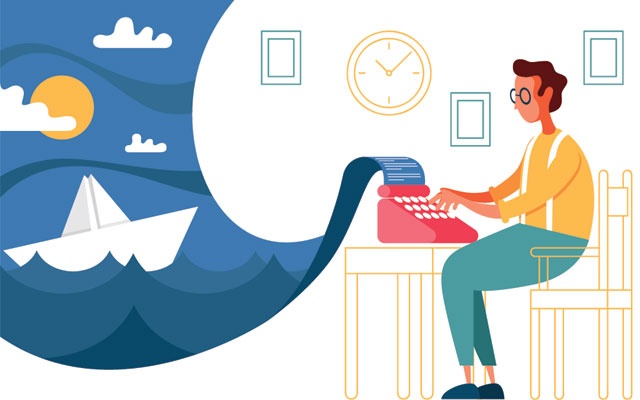Course Description
Paranormal romance is all the rage lately. From books to movies, sexy vampires and gothic love stories are blazing up the bestseller lists and hitting the top of the box office.
Paranormal romance falls under the umbrella term 'speculative fiction' which is just a term that encompasses fiction genres that are more fantastic, like science fiction, fantasy, horror and paranormal, among others.
You may enjoy reading these books and watching these movies so much that you are sure you could write one yourself--or at least you are interested in trying. But just liking the genre isn't enough to make you a paranormal romance writer. You need to know more about paranormal romance writing and what it entails--the rules, what to include, what not to include, what makes a good story, and much more...that's where this class can help.
Defining the Term
Paranormal. That word is bandied about quite a lot, but what is the definition? Dictionary developer Merriam-Webster states that the word paranormal means "not specifically explainable: supernatural."
Anything defined as "not specifically explainable" leaves one a lot of wiggle room. Yes, there are rules to writing a paranormal romance, and this course covers those rules. But before you start this course, you just need to know that when you write, you must keep in mind that the paranormal romance is much different from any other type of fiction precisely because of that very definition.
In other genres, authors must explain their plot happenings either along the way or wrap them up in a tidy bow at the end, with a plausible explanation. If they did not, their readers would no longer be their readers.
Think about it: If you are reading along in a great mystery and at the end all those unexplained plot twists and cliffhangers were left unexplained, wouldn't you feel cheated? Of course! We read those books so that we can feel a bit challenged, try to work out for ourselves what is going on, and then be rewarded at the end with a great explanation or a bit of fanfare that we have figured it out on our own.
Suspension of Disbelief
For those who have not heard the term before, suspension of disbelief, or the "willing suspension of disbelief," is simply the way one justifies reading, hearing, or seeing the fantastic or nonrealistic elements in a work. This completely applies to the entire paranormal genre, including the paranormal romance.
Here we can have a woman fall in love with a werewolf, as in the movie Wolfman starring Benicio del Toro, and have our audience come along for the ride, rooting for both these crazy kids to just get it together and make it work. Yes, the audience knows there is no such thing as a werewolf; and if there were, there is no woman out there really willing to take up this arduous task, including chaining him up during a full moon, cleaning up all that pesky pet hair, dealing with the idea that her hubby may just mistake her for a juicy steak one night, never being able to enjoy a romantic evening during a full moon, having to cancel her plans several times a month or year, whenever the full moon shows up on the calendar, in order to make sure her husband does not get out and kill the neighbors. Even so, for just a few hours we can lose ourselves in these books and enjoy the moment, as we suspend our disbelief and just give ourselves over to the story.
This is what you must create. You must create a world into which your reader will willingly go, one in which he or she will shed that disbelief at the door and crawl deeper and deeper into your narrative, staying there until the denouement.
Remember, there are no new ideas under the sun; it has all been done. However, the new twists and turns you create for your characters are new. The world, the characters, the conflicts, and motivations you create are yours, and should be uniquely so. While there are not really any new ideas on the paranormal romance out there, the world you create will be your own. Make your readers love it and want to stay there as much as you do. Make them wait breathlessly for your next book!
In Summary
This class is designed to help you do just that. One hopes that you already have an idea, or the tiny seedling of an idea, for a paranormal romance somewhere deep down inside. Over the course of this class you can develop it, nurture it, and at the end, come away with something you can send to an agent.
- Completely Online
- Self-Paced
- Printable Lessons
- Full HD Video

- 6 Months to Complete
- 24/7 Availability
- Start Anytime
- PC & Mac Compatible
- Android & iOS Friendly
- Accredited CEUs

Learning Outcomes
- Describe the popular world of the paranormal romance.
- Describe the elements of a paranormal romance.
- Summarize thinking about the big picture.
- Describe paranormal stereotypes and clichès.
- Describe the supernatural, magical creatures.
- Describe heroes.
- Describe the heroine.
- Summarize plotting and plot maps.
- Describe pacing.
- Demonstrate dialogue.
- Summarize the necessary processes of editing and re-editing.
- Describe the process of finding an agent for your work.
- Demonstrate how to create a proper query letter for a prospective agent or publisher.
- Demonstrate mastery of lesson content at levels of 70% or higher.
Assessment Guide
| Assessment | Points |
|---|---|
| Assignment 1 Introduction | 1 points |
| Assignment 1B Suspension of Disbelief | 20 points |
| Lesson 1 Quiz | 6 points |
| Assignment 2: Using Backstory in Your Writing | 20 points |
| Lesson 2 Quiz | 8 points |
| Assignment 3 : Big Picture Thinking | 15 points |
| Lesson 3 Quiz | 5 points |
| Assignment 4: Clichés and Stereotypes | 20 points |
| Lesson 4 Quiz | 6 points |
| Assignment 5: Creating a Supernatural Character | 20 points |
| Lesson 5 Quiz | 7 points |
| Assignment 6: Creating Your Hero | 20 points |
| Lesson 6 Quiz | 5 points |
| Assignment 7: Writing Your Heroine | 20 points |
| Lesson 7 Quiz | 5 points |
| Lesson 8: Plotting | 20 points |
| Lesson 8 Quiz | 6 points |
| Assignment 9: Pacing Your Novel | 20 points |
| Lesson 9 Quiz | 25 points |
| Assignment 10: Writing Dialogue | 25 points |
| Lesson 10 Quiz | 20 points |
| Assignment 11: Editing | 15 points |
| Lesson 11 Quiz | 21 points |
| Assignment 12: Agent Research | 15 points |
| Lesson 12 Quiz | 25 points |
| Assignment 13: The Query Letter | 15 points |
| Lesson 13 Quiz | 25 points |
| Assignment 14: The Final Assignment | 30 points |
| Lesson 14 Quiz | 25 points |
| The Final Exam | 165 points |



















